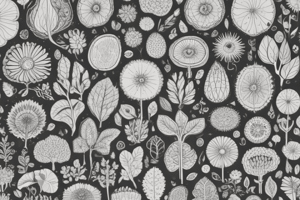Podcast
Questions and Answers
What is the main characteristic that distinguishes plants from animals?
What is the main characteristic that distinguishes plants from animals?
- Motility
- Ability to produce their own food (correct)
- Variety of body structures
- Presence of cell walls
Which of the following is a characteristic of plant cell walls?
Which of the following is a characteristic of plant cell walls?
- Composed of chitin
- Composed of cellulose (correct)
- Present in animals
- Absent in plants
Which group of plants is characterized by the presence of vascular tissue?
Which group of plants is characterized by the presence of vascular tissue?
- Pteridophyta
- Bryophyta
- Tracheophyta (correct)
- Angiosperms
What is the main characteristic that distinguishes vertebrates from invertebrates?
What is the main characteristic that distinguishes vertebrates from invertebrates?
Which of the following is an example of an invertebrate animal?
Which of the following is an example of an invertebrate animal?
What is the characteristic that distinguishes angiosperms from gymnosperms?
What is the characteristic that distinguishes angiosperms from gymnosperms?
Study Notes
Characteristics of Plants
- Autotrophic organisms: produce their own food through photosynthesis
- Cell walls composed of cellulose
- Chloroplasts present, containing pigment chlorophyll
- Roots, stems, and leaves as primary organs
- Non-motile, stationary organisms
Characteristics of Animals
- Heterotrophic organisms: obtain energy by consuming other organisms
- Cell walls absent or composed of chitin
- No chloroplasts or chlorophyll present
- Variety of body structures and organs
- Motile, able to move from place to place
Plant Classification
- Divided into two main groups: Bryophyta (non-vascular) and Tracheophyta (vascular)
- Tracheophyta further divided into:
- Ferns (Pteridophyta)
- Gymnosperms (seed-producing, e.g., conifers)
- Angiosperms (flowering plants)
Animal Classification
- Divided into two main groups: Invertebrates (without backbone) and Vertebrates (with backbone)
- Invertebrates:
- Sponges (Porifera)
- Cnidarians (jellyfish, corals)
- Worms (Annelids, Platyhelminthes)
- Mollusks (squid, octopuses, clams)
- Echinoderms (starfish, sea urchins)
- Vertebrates:
- Fish ( Pisces)
- Amphibians (frogs, toads)
- Reptiles (snakes, lizards, turtles)
- Birds (Aves)
- Mammals (warm-blooded, e.g., humans, primates)
Characteristics of Living Organisms
- Plants are autotrophic, meaning they produce their own food through photosynthesis
- Plant cell walls are composed of cellulose
- Chloroplasts are present in plant cells, containing the pigment chlorophyll
- Plants have three primary organs: roots, stems, and leaves
- Plants are non-motile, meaning they are stationary organisms
Characteristics of Animals
- Animals are heterotrophic, meaning they obtain energy by consuming other organisms
- Animal cells lack cell walls or have cell walls composed of chitin
- Chloroplasts and chlorophyll are absent in animal cells
- Animals have a variety of body structures and organs
- Animals are motile, meaning they are able to move from place to place
Plant Classification
- Plants are divided into two main groups: non-vascular (Bryophyta) and vascular (Tracheophyta)
- Vascular plants are further divided into three groups:
- Ferns (Pteridophyta)
- Gymnosperms (seed-producing, e.g., conifers)
- Angiosperms (flowering plants)
Animal Classification
- Animals are divided into two main groups: invertebrates (without backbone) and vertebrates (with backbone)
- Invertebrates include:
- Sponges (Porifera)
- Cnidarians (jellyfish, corals)
- Worms (Annelids, Platyhelminthes)
- Mollusks (squid, octopuses, clams)
- Echinoderms (starfish, sea urchins)
- Vertebrates include:
- Fish (Pisces)
- Amphibians (frogs, toads)
- Reptiles (snakes, lizards, turtles)
- Birds (Aves)
- Mammals (warm-blooded, e.g., humans, primates)
Studying That Suits You
Use AI to generate personalized quizzes and flashcards to suit your learning preferences.
Description
Learn about the distinct features of plants and animals, including their nutrition, cell structure, and organs. Test your knowledge of the differences between these two kingdoms of life.




